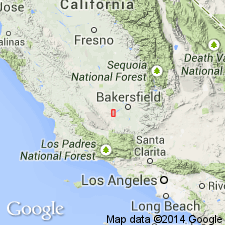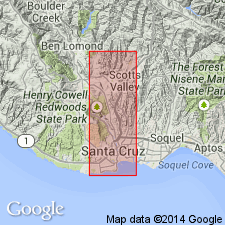
- Usage in publication:
-
- Carman Sandstone Member*
- Modifications:
-
- Original reference
- Adopted
- Dominant lithology:
-
- Sandstone
- Siltstone
- AAPG geologic province:
-
- San Joaquin basin
Summary:
Pg. D15-D23. Carman Sandstone Member, uppermost of two members of Etchegoin Formation. ["First used" by Maher and others (1972) who credit this author as in press]. Consists of gray, interbedded siltstone and sandstone. Thickness is 1,292 feet thick at type. Divided into 4 informal sand zones (ascending): Calitroleum, Gusher, Wilhelm, and Mulina. Includes important petroleum reservoirs in sandstone beds. Overlies Tupman Shale Member (new) of Etchegoin Formation. Underlies San Joaquin Formation. Age is Pliocene. Report includes electric log, detailed lithologic description of core, charts showing distribution of fossils. (Carman Sandstone Member of Etchegoin Formation adopted by the USGS.)
Type section (subsurface): depth-interval 2,095 to 3,387 ft, Unit Operation Naval Petroleum Reserve No.1 (NPR-1) well 324-19R, west part of Elk Hills oil field, Elk Hills, NW/4 sec. 19, T. 30 S., R. 23 E., San Joaquin Valley, Kern Co., CA. Named from old Standard Oil Hay-Carman Camp, in sec. 36, T. 30 S., R. 23 E., where discovery well of Elk Hills oil field was drilled in 1919.
[Discrepancy: age of member is listed as Pliocene in this publication, and in GNC records (Changes in stratigraphic nomenclature, 1973, USGS Bull. 1395-A) and GNU records (USGS DDS-6; Menlo GNULEX); it is listed as late Pliocene in US geologic names lexicon (USGS Bull. 1520, p. 52), which is here considered a Misprint.
According to US geologic names lexicon (USGS Bull. 1520, p. 53), thickness of Carman ranges from 275 to 650 m --uncertain how derived; report focuses on single core.]
Source: Publication; GNU records (USGS DDS-6; Menlo GNULEX); Changes in stratigraphic nomenclature, 1973 (USGS Bull. 1395-A, p. A8-A9); US geologic names lexicon (USGS Bull. 1520, p. 52-53).

- Usage in publication:
-
- Carman Sandstone Member*
- Modifications:
-
- Biostratigraphic dating
- AAPG geologic province:
-
- San Joaquin basin
Summary:
Age of Etchegoin Formation is late Miocene (International Epoch assignment) based on vertebrate evidence of otarioid fauna, PLIOPEDIA PACIFICA and Arctocephaline aff. CALLORHINUS, collected from Kettleman Hills, California. Estimated age is 7 to 4 Ma. [Mammalian Provincial] Stage - Age association is Hemphillian and "Etchegoin." [Age of Carman Sandstone Member not addressed in report but age is late Miocene based on age of Etchegoin Formation.]
Source: GNU records (USGS DDS-6; Menlo GNULEX).
For more information, please contact Nancy Stamm, Geologic Names Committee Secretary.
Asterisk (*) indicates published by U.S. Geological Survey authors.
"No current usage" (†) implies that a name has been abandoned or has fallen into disuse. Former usage and, if known, replacement name given in parentheses ( ).
Slash (/) indicates name conflicts with nomenclatural guidelines (CSN, 1933; ACSN, 1961, 1970; NACSN, 1983, 2005, 2021). May be explained within brackets ([ ]).

